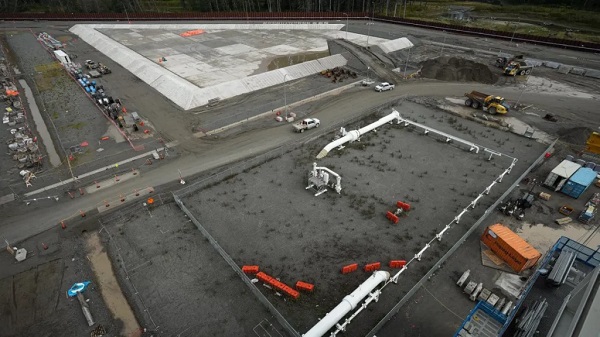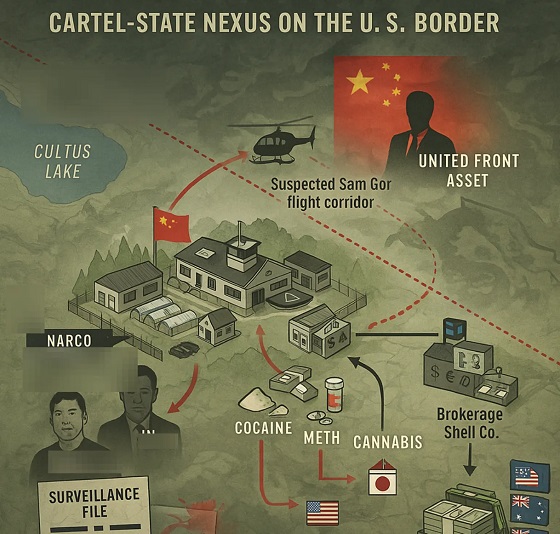Alberta
Indoor masking is back – Province taking action to reduce hospitalizations
Further actions to protect health system from COVID-19
Due to increasing COVID-19 transmission and rising hospital admissions, overwhelmingly amongst unvaccinated Albertans, temporary measures are needed to reduce transmission and prevent the health-care system from being overwhelmed.
Currently, more than 80 per cent of COVID-19 cases in hospital are unvaccinated, including 91 per cent of patients in intensive care.
“Vaccines are safe, effective, and a game-changer. This is why the current wave is different than what we’ve experienced before. While we do not need to return to the same widespread and dramatic measures we had in place earlier in the pandemic, unvaccinated Albertans in particular are still at risk and are placing a heavy load on our health-care system. This is why we are taking measured steps and introducing a new incentive program to encourage more Albertans to get the jab.”
“As I have always done, I use the best currently available evidence from Alberta and around the world to inform my recommendations to protect the health of Albertans. With hospitalization rates rising, it is important that we take additional steps to help reduce the spread of COVID-19. My ultimate goal continues to be to shift from pandemic to endemic and put more focus on the complete health of Albertans – we must learn to live with COVID. Getting vaccinated today is the best possible way for us to get there.”
New vaccine incentive program
A one-time incentive of $100 is now available for all Albertans age 18 or older who receive a first or second dose of vaccine between Sept. 3 and Oct. 14.
This incentive is intended to encourage unvaccinated Albertans to get protected as soon as possible.
After vaccination, eligible Albertans will be able to register online. Alberta Health will validate registrations against provincial immunization data. This website will be available starting on Sept. 13. If Albertans do not have access to a computer, they can contact 310-0000 for assistance, starting on Sept. 13.
Temporary measures
- The province will make masks mandatory for all indoor public spaces and workplaces starting Sept. 4 at 8 a.m. Schools are not required to implement masking but school boards will continue to set COVID-19 management policies as they deem appropriate.
- Also, as of Sept. 4 at 8 a.m., restaurants, cafés, bars, pubs, nightclubs and other licensed establishments will be required to end alcohol service at 10 p.m.
- In addition, Albertans are encouraged to limit in-person contacts. To support this, the province strongly recommends that unvaccinated Albertans limit their indoor social gatherings to close contacts of only two cohort families up to a maximum of 10 people.
- It is also recommended that employers pause their plans to have staff return to work and instead continue with work-from-home measures. If employees are working on location, employees must mask for all indoor settings, except in work stations or where two-metre physical distancing or adequate physical barriers are in place.
Additional vaccine incentives
All Albertans who have received two doses of vaccine and are aged 18 and over are eligible for the remaining $1-million draw for the Open for Summer Lottery. To register and for complete details, visit alberta.ca/lottery. The final draw closes Sept. 23.
Fully protected Albertans are also eligible to enter the Outdoor Adventure vaccine lottery. To register and for complete details, visit alberta.ca/outdoor-adventure-
Book an appointment and get vaccinated
All Albertans can book appointments via AHS online or by calling 811, or through participating pharmacies. Walk-in appointments for first doses are also available. For schedule and locations, visit ahs.ca/vaccine.
Updated modelling
Based on information available in mid-August, an updated projection of estimated COVID-19 cases and hospitalizations to the end of September was developed. Current actual data is trending toward the high end of the projections, therefore numbers may exceed the projections. Peaks in the model are only estimates, and actual peaks may be higher and later than anticipated if current growth trends continue.
This provincial modelling shows intensive care unit patients could possibly peak at around 180 in the medium scenario, although if accelerating trends continue, numbers could reach or exceed the currently projected high scenario at 290.
Other hospitalizations (non-ICU) are currently trending toward the high scenario, with a potential peak of 700 in the next several weeks. If the high scenario peaks are reached, this would mean a greater combined impact on the acute care system than in all previous waves, and if changes in transmission cause greater spread, these numbers could be exceeded.
Modelling is for the entire province. Some regions will experience different case and hospitalization statistics per capita; this will particularly be expected in those areas with lower rates of vaccinations.
Modelling is a dynamic process where there are constant comparisons against observations versus projections. When these comparisons deviate, the model assumptions are re-evaluated, which may change with new information such as outbreak events.
This modelling is now available online. A separate evidence summary has also been posted, including key assumptions and considerations, hospital impact modelling that was developed in June to inform changes announced in late July, and a reference list for further reading.
Alberta
Meet Marjorie Mallare, a young woman with a leading role at one of Canada’s largest refineries
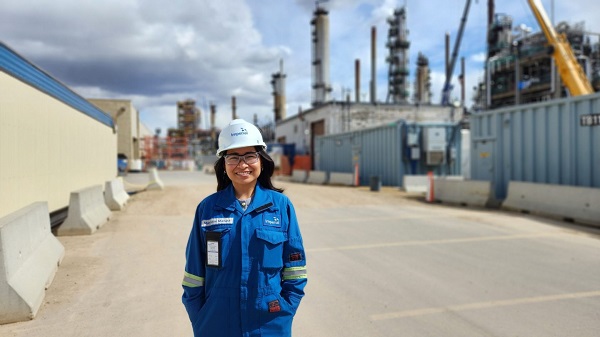
Marjorie Mallare at Imperial Oil’s Strathcona refinery.
Fr0m the Canadian Energy Centre
By Cody Ciona
Mallare manages an all-female team of engineers helping keep operations smooth and safe
As the utilities and hydroprocessing technical lead for Imperial Oil’s Strathcona Refinery near Edmonton, 32-year-old Marjorie Mallare and her team help ensure operations run smoothly and safely at one of Canada’s largest industrial facilities.
The exciting part, she says, is that all four engineers she leads are female.
It’s part of the reason Mallare was named one of ten Young Women in Energy award winners for 2025.
“I hope they realize how important the work that they do is, inspiring and empowering women, connecting women and recognizing women in our industry,” she says.
“That can be very pivotal for young women, or really any young professional that is starting off their career.”
Born and raised in the Philippines, Mallare and her family moved to Edmonton near the end of junior high school.
Living in the industrial heartland of Alberta, it was hard not to see the opportunity present in the oil and gas industry.
When she started post-secondary studies at the University of Alberta in the early 2010s, the industry was booming.
“The amount of opportunities, at least when I started university, which was around 2011, was one of the high periods in our industry at the time. So, it was definitely very attractive,” Mallare says.
When choosing a discipline, engineering stood out.
“At the time, chemical engineering had the most number of females, so that was a contributing factor,” she says.
“Just looking at what’s available within the province, within the city, chemical engineering just seemed to offer a lot more opportunities, a lot more companies that I could potentially work for.”
Through work co-ops in oil and gas, her interest in a career in the industry continued to grow.
“It just kind of naturally happened. That drew my interest more and more, and it made it easier to find future opportunities,” Mallare says.
Following a work practicum with Imperial Oil and graduation, she started working with the company full time.
On the side, Mallare has also driven STEM outreach programs, encouraging young women to pursue careers in engineering.
In addition to supporting the Strathcona Refinery’s operations department, Mallare and her team work on sustainability-focused projects and reducing the refinery’s carbon footprint.
The 200,000 barrel per day facility represents about 30 per cent of Western Canada’s refining capacity.
“Eventually, our group will also be responsible for running the new renewable diesel unit that we’re planning to commission later this year,” says Mallare.
Once completed, the $720 million project will be the largest renewable diesel facility in Canada, producing more than one billion litres of biofuel annually.
Projects like these are why Mallare believes Canada will continue to be a global energy leader.
“We’re leading others already with regards to pursuing more sustainable alternatives and reducing our carbon footprints overall. That’s not something we should lose sight of.”
Alberta
Alberta Precipitation Update
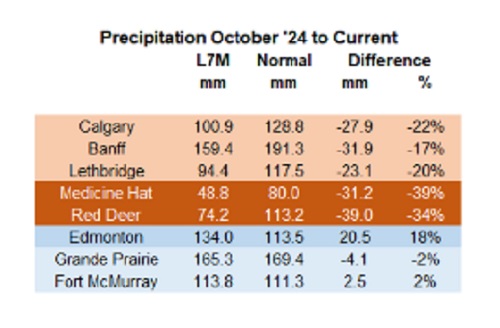
Below are my updated charts through April 2025 along with the cumulative data starting in October 2024. As you can see, central and southern Alberta are trending quite dry, while the north appears to be faring much better. However, even there, the devil is in the details. For instance, in Grande Prairie the overall precipitation level appears to be “normal”, yet in April it was bone dry and talking with someone who was recently there, they described it as a dust bowl. In short, some rainfall would be helpful. These next 3 months are fairly critical.
Thanks for reading William’s Substack!
Subscribe for free to receive new posts and support my work.
-
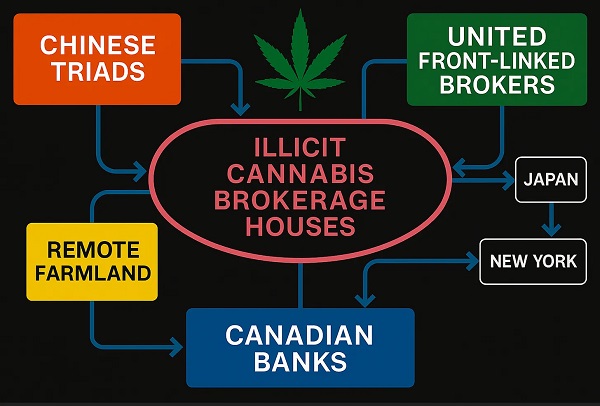
 Crime1 day ago
Crime1 day agoHow the CCP’s United Front Turned Canada’s Legal Cannabis Market into a Global Narcotics Brokerage Network
-
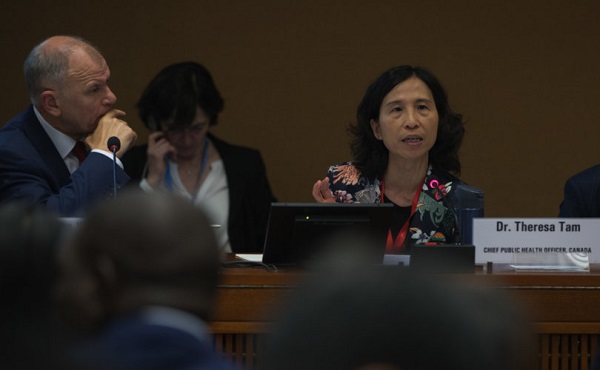
 COVID-192 days ago
COVID-192 days agoCanada’s top doctor signed oath to withhold COVID info that could ‘embarrass’ Trudeau’s cabinet: records
-

 Alberta1 day ago
Alberta1 day agoAlberta Precipitation Update
-

 International2 days ago
International2 days agoFirst American pontiff says ‘build bridges’ to peace
-

 Business1 day ago
Business1 day agoReal Challenges Await Carney
-
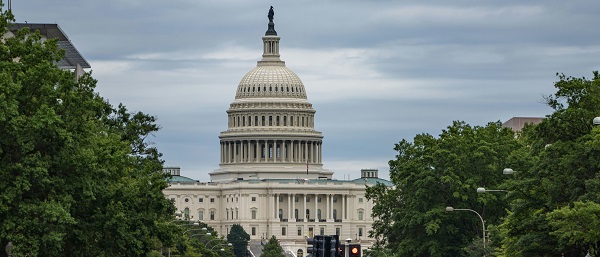
 espionage1 day ago
espionage1 day agoGOP rep moves to shred PATRIOT Act, dismantle Deep State spy powers
-

 Daily Caller23 hours ago
Daily Caller23 hours agoStates Attempting To Hijack National Energy Policy
-

 Business6 hours ago
Business6 hours agoLEGO to invest $366 million on major U.S. expansion



